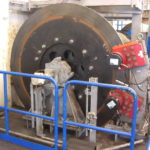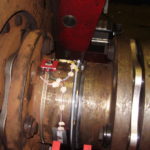Sensors and data transmission technology opens up new possibilities to reduce inefficiencies and costs from downtimes. Prüftechnik uses its condition monitoring system to keep container cranes operational. The learning curve is steep
Hamburg, gateway to the world – but when the machines stop running, the gateway is closed.
No container reaches the quay[ds_preview], none leaves the port. This scenario would result in financial loss at the end of the day for port operators as well as shipping companies. A crane has to operate so ships can be loaded and unloaded 24/7. Continuous condition monitoring helps to avoid stand-stills, to formulate maintenance tasks more clearly and to save significant amounts of money in the end.
While modern container ship giants move relatively slowly across the oceans, operation on land has to be even faster. Unload cargo, load new cargo, leave port and sail on to the next stop. But when the crane doesn’t run, the tight schedule of the container vessels starts to topple and every minute costs money. Six-digit compensation fees, in some cases even more, have to be paid during medium- and long-term down-periods. To avoid this risk, monitoring of all critical components is necessary. However, a ship-to-shore crane is a very complex system with a lot of critical elements involved that individually or altogether bear an enormous damage potential. An intelligent Condition Monitoring System (CMS) does identify such potential damaging factors early and counter possible downtimes.
At terminal operator Eurogate in the port of Hamburg the container cranes operate 24/7. To monitor one of the a ship-to-shore cranes, a simple, temporary CMS was installed. At the same time, the crane’s operator had an eye on his machine every day. Being so close to the crane, he could feel any vibration and change in the system’s behaviour, which will prove to be an important factor later on.
Shortly after the installation of the CM-technology, the gearboxes of two cranes failed. Diagnosis: damaged bearings on the fourth gear shaft. After a number of tests of a test gearbox (e.g. emergency stop at overload conditions) it became very clear that bearboxes had to be reinforced to permanently withstand the maximum torque of 500,000 Nm.
Because list of measures to ensure the gearbox runs without downtimes was not fully exploited, seven more gearboxes had to be exchanged in the time to follow. Notably the sensitivity of the crane operator led to the detection of the reoccurring, abnormal vibrations.
The noise at high loads, maximum lifting speed and a warm gearbox were an indicator for a soon-to-fail gearbox. The crane even had to be completely shut down twice. After dismantling the cause of the vibrations was found: a tilting gear on the shifting shaft and bearing showing conspicuous wear on the outer ring and rolling element.
The machine had only been running for 1,087 hours but is designed for 50 times more. The reason for the destruction: the system’s dimensions for a maximum of 500,000 Nm were still designed too small. New measurements showed peak values of up to 930,000 Nm under real operating conditions.
This raised questions about the usefulness of the installed CMS. Would the damages in the gearbox have been avoidable? A closer look at the measurement data revealed that they didn’t have much significance. Only long-term trends had been recorded but no spectra or synchronous short-term observations.
To be able to guarantee undisrupted running time, a new comprehensive CMS is needed. At the same time, it has to be ensured that data sets can be interpreted properly and allow a reliable prediction of possible downtimes or maintenance work ahead.
Since peak loads mostly occur during braking processes, especially during emergency stops, the requirements for the system were quite specific. Presumably, differences in timing of the system response lead to the problems in the gearbox described above. The brake and the motors theoretically receive the signal »stop« at the same time, but a delayed response within the system can cause the master motor to stop while the slave motor is still turning and the brake already engages. This causes the damaging loads within the gearbox. Possibly theses differences can be tackled by changes in the controls.
These coherences have to be checked via measurement. Additionally, experts are needed to properly evaluate the data. Prüftechnik is one of those partners for professional and continuous condition monitoring. The Bavarian condition monitoring specialist delivers measurement technology as well as know-how through its in-house Monitoring Center.
To continuously monitor the ship-to-shore container crane, Prüftechnik deploys its VIBGUARD system. It features 20 synchronous channels with every channel processing a multitude of measurement data. Thus, all critical measurement points in the engine and the gearbox are covered. All 20 channels are in use:
12 x vibration acceleration
4 x tensions (indirect measurement of force)
3 x torque
1 x temperature
The permanent flow of data from the VIBGUARD CM system is being buffered by an industrial computer and sent to the cloud of the Prüftechnik Monitoring Center as an e-mail via a GSM connection. At the Monitoring Center certified vibration experts (ISO CAT I-III) analyse and evaluate the data. During the undisrupted operation, Eurogate gets reports on the engine’s condition on a regular basis via e-mail. At the same time, the owner of the crane receives all relevant parameters and alarms directly via CAN-BUS connection into his control system where he can check it for damage potential and take action if necessary.
Vice versa, the VIBGUARD system is fed via CAN-BUS with information on the procedural position of the crane and the associated loads.
The individual trends and spectra of the VIBGUARD system allow a very deep insight into the machine’s condition. Thus, after only a short time, a possible cause for the increased vibration levels of the past can be identified. The evaluation of the oil temperature compared to the vibration acceleration in the main gearbox is significant. It shows that the lubrication properties dramatically change when the oil temperature falls below 20 °C, having a massive influence on the engine’s behaviour.
As a counter measure a heating system keeps the oil heated and prevents its temperature from sinking below the critical value also during downtimes and low outside temperatures. At the same time, maintenance work starts to readjust machine and control parameters based on measurement results. Which positive results this will have will be shown by future measurement data and results. It remains to be examined if in this concrete case a different type of oil with different properties in cool temperatures is required. Possibly, changes in temperature do also have a direct effect on bearings and gears inside the gearbox, causing shock excitation even without the influence of the oil temperature. The vibration measurements with VIBGUARD and the cooperation with Prüftechnik’s Monitoring Center will be expanded to cover further ship-to-shore cranes. Thus, unnecessary downtimes can be avoided. A running machine saves costs that otherwise would be caused by spare parts logistics, working hours and downtime compensation fees.



















